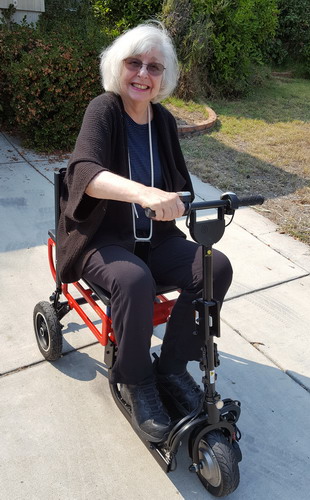Back in the old days, a head forward posture was the sign of a serious nerd or other types of bookworm or the special province of people over 60. Since the development of computers, and now even worse the cell phone, the head forward posture is a modern epidemic. Whatever posture we assume a lot becomes permanent. Our body is
always trying to adapt to the stresses put upon it, and habitual postures are a chronic stress.
the special province of people over 60. Since the development of computers, and now even worse the cell phone, the head forward posture is a modern epidemic. Whatever posture we assume a lot becomes permanent. Our body is
always trying to adapt to the stresses put upon it, and habitual postures are a chronic stress.
Posture is the consequence of the balance of all the muscles pulling on the spine. Repetitive abnormal postures cause certain muscles to shorten and tighten, and others to lose strength and lengthen. When you bend your head forward to look at your cell phone or bend forward to stare at a computer screen, the muscles in the front of your neck and at the base of your skull tighten and shorten. The deep muscles around the spine weaken and
lengthen to allow the neck to stretch and the head to pull forward. Several bad things happen as a result.
Imagine your skull is a 10 to 12-pound bowling  ball. When it is balanced over your shoulders, it is held up by the spine. Your neck muscles are there to move your head around to see what's happening. But when your head is forward, gravity tries to drop your head onto your chest. Consequently the neck muscles
have to pull back to keep this from happening. This pull compresses the spine, crushing down on the vertebra and discs. Over time this induces spinal arthritis, disc degeneration, and neuritis in the nerves. That means your neck hurts, does not turn well, and you get tingling, numbness, and even pain in the nerves down your arms and into your hands. This is not a good thing. Eventually it progresses to actual spastic paralysis in the arms. I have seen several
patients end up with metal hardware screwed into their neck vertebra to try to straighten the neck out and relieve the pressure on the nerve roots.
ball. When it is balanced over your shoulders, it is held up by the spine. Your neck muscles are there to move your head around to see what's happening. But when your head is forward, gravity tries to drop your head onto your chest. Consequently the neck muscles
have to pull back to keep this from happening. This pull compresses the spine, crushing down on the vertebra and discs. Over time this induces spinal arthritis, disc degeneration, and neuritis in the nerves. That means your neck hurts, does not turn well, and you get tingling, numbness, and even pain in the nerves down your arms and into your hands. This is not a good thing. Eventually it progresses to actual spastic paralysis in the arms. I have seen several
patients end up with metal hardware screwed into their neck vertebra to try to straighten the neck out and relieve the pressure on the nerve roots.
So the big message here is that the neck forward posture is a bad thing. Forward for a day, or a week, or a month may not produce any real consequence you notice. The damage is cumulative over a long time, so it sneaks up on us. By the time you get  obvious symptoms, the damage is already fairly progressed. Now is the time
to change this posture pattern, not later. However there is an even bigger reason to start now working on this posture pattern – brain degeneration. As we age, the portion of the brain that feeds the extensor muscles of the body gets weaker. This is why almost every old person has that bent forward posture, even if they have never looked at a cell phone, computer, or even read a book. The extensor muscles are the muscles that hold the body upright – usually
from the back of the body. Brain degeneration can be fought through diligent effort. The more you stimulate a brain area the stronger it gets. This is why activities that contract the extensor muscles are very important.
obvious symptoms, the damage is already fairly progressed. Now is the time
to change this posture pattern, not later. However there is an even bigger reason to start now working on this posture pattern – brain degeneration. As we age, the portion of the brain that feeds the extensor muscles of the body gets weaker. This is why almost every old person has that bent forward posture, even if they have never looked at a cell phone, computer, or even read a book. The extensor muscles are the muscles that hold the body upright – usually
from the back of the body. Brain degeneration can be fought through diligent effort. The more you stimulate a brain area the stronger it gets. This is why activities that contract the extensor muscles are very important.
The protocol for reversing and preventing a head forward posture is a combination of exercising the muscles that hold the spine erect and stretching out the muscles that are shortening, contracting, and causing the problem. I have reviewed numerous good programs for correcting this posture, however I find they all seem to be lacking a couple key factors. They all focus on the neck muscles, which is the obvious place to go, but posture is a
whole-body process. The second factor is that posture is designed to be an unconscious process, and all the exercises are very conscious muscle intervention oriented. To be truly useful we need to set things up so that having good posture is actually more comfortable than the bad posture. If you think about what is causing the bad posture in the first place in  most
circumstances, it is a vision issue. We are moving our heads closer to something we are trying to see. Clear vision is a higher priority than muscle comfort. So no matter how much stretching and muscle work we do, if we can't see, we are still going to pull our head forward to see better.
most
circumstances, it is a vision issue. We are moving our heads closer to something we are trying to see. Clear vision is a higher priority than muscle comfort. So no matter how much stretching and muscle work we do, if we can't see, we are still going to pull our head forward to see better.
From my perspective our first job in correcting our posture is to correct our ergonomics when reading. Passive corrections involve making sure our computer workspace is ergonomically set up with a  good chair, proper desk height, keyboard and monitor at the proper height, and the monitor close enough that we see clearly and easily without
having to lean forward at all. I have even recommended to a few patients over the years that they buy some simple magnifying reading glasses to use for the computer that will make the screen appear closer. This naturally makes them set their head further back. Now recently I see optometrists are offering computer glasses for this same purpose. A patient also suggested that you could set the view on your computer to make the print larger and more easily seen.
good chair, proper desk height, keyboard and monitor at the proper height, and the monitor close enough that we see clearly and easily without
having to lean forward at all. I have even recommended to a few patients over the years that they buy some simple magnifying reading glasses to use for the computer that will make the screen appear closer. This naturally makes them set their head further back. Now recently I see optometrists are offering computer glasses for this same purpose. A patient also suggested that you could set the view on your computer to make the print larger and more easily seen.
I suppose the same trick could be used with cell phones, setting the text size larger as well as using reading glasses. But the direct route of holding the phone up far enough to keep your head level while viewing the phone is also essential. This is more  effort with your arm, but since the ultimate outcome of having a lazy phone arm
is losing the nerves to the arm altogether, the effort is worth it. This requires the mindset similar to delayed gratification; the long term goals outweigh the short term inconvenience. The same will be true with anything you are reading: books, newspapers, kindle, magazines, whatever.
effort with your arm, but since the ultimate outcome of having a lazy phone arm
is losing the nerves to the arm altogether, the effort is worth it. This requires the mindset similar to delayed gratification; the long term goals outweigh the short term inconvenience. The same will be true with anything you are reading: books, newspapers, kindle, magazines, whatever.
Here are several links to good workouts for correcting head forward posture:
https://www.youtube.com/watch?v=wQylqaCl8Zo
This link demonstrates the traditional physical therapy approach to stretching the tight neck muscles and strengthening the weak ones. This is good as far as  it goes, but I find that to address the bigger issue behind the head forward posture involves the pattern of rounded forward shoulders and slumped convex low back. The muscles
between the shoulder blades need to be strengthened as well as the muscles from the shoulders to the lower mid-back.
it goes, but I find that to address the bigger issue behind the head forward posture involves the pattern of rounded forward shoulders and slumped convex low back. The muscles
between the shoulder blades need to be strengthened as well as the muscles from the shoulders to the lower mid-back.
https://backintelligence.com/how-to-fix-forward-head-posture/
https://www.youtube.com/watch?v=5R54QoUbbow
https://www.youtube.com/watch?v=YLR2Vm346Lc
Additionally, the low back stabilizer muscles need strength to keep the proper forward curve to the low back. This is also important for stability in the low back which is such an issue due to all the sitting we do these days. These links deal more with these mid and lower back concerns.
https://www.youtube.com/watch?v=vmhu-yZGY_A
And here is a nice one on how to sit and decompress your spine.
Sit With Less Pain: Foundation Training Seated Decompression
As you can see, perusing these videos, there is a lot you can do without any special equipment to correct your posture.
As a last step in this process, since none of the presentations mentioned this, is how you make these muscle changes more automatic; not requiring constant thought. The trick to this is to make them part of a different goal, particularly one that requires balance. Once you get your posture well-aligned through the exercises shown above, add in a new element like trying to balance something on your head. Start with something easy like a
pillow, and increase the difficulty with more challenging objects. Another balance challenge is to start doing these  exercises with your eyes closed and sitting on a therapy ball or standing on a balance board. These combination activities drive the training of the posture muscles deeper into the automatic
realm.
exercises with your eyes closed and sitting on a therapy ball or standing on a balance board. These combination activities drive the training of the posture muscles deeper into the automatic
realm.
The more you do these balance and posture exercises, the more you stimulate the brain to keep it healthy. These are moves you want to keep engaging for the rest of your life. These muscles and nerves need constant stimulation forever. Looking over these videos, you should be able to pick out a few to do regularly to keep your brain, back, and neck happy.
Take care,
David
Wow, the Death by Covid article I wrote 2 weeks ago just got validated by the CDC. I wrote that it was the co-morbidities that made a person a target for covid 19 death. Now on their website (see
here) they state that 94% of the people that have died with covid 19 had an average of 2.6 comorbidities which they were already sick with. Only 6% of reported covid deaths had no comorbidities listed at the time of death that were pre-existing medical conditions that the patients were being treated for. They may have had other comorbidities that were not reported.
We have received the second batch of 20  copies of my book The Balanced Life. For those of you that signed up for the book last year, we have set
your copies aside. They are available in the office for $17.99, and they are also available on Amazon.com
copies of my book The Balanced Life. For those of you that signed up for the book last year, we have set
your copies aside. They are available in the office for $17.99, and they are also available on Amazon.com
Ellen update: 
After almost a year of waiting, the Kick Starter project we paid for has arrived. The whole Covid thing really slowed the production. We signed up for an eFOLDI light - an electric light weight folding wheelchair that can be folded up to a suitcase size and tossed in the back of the car. Here Ellen is on her first test
run!

